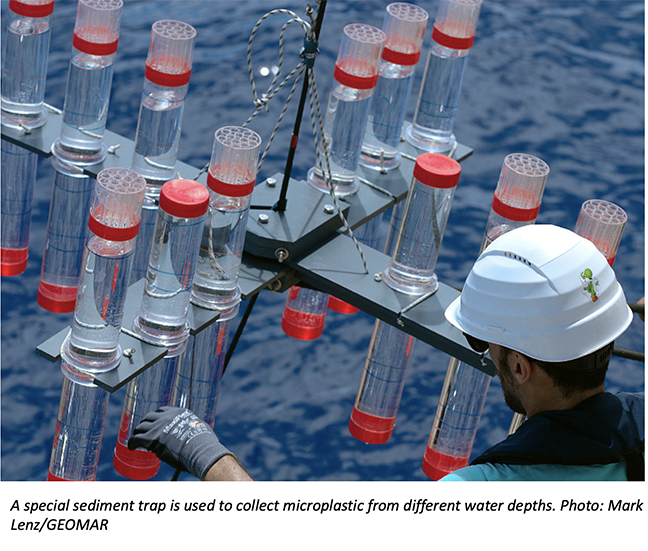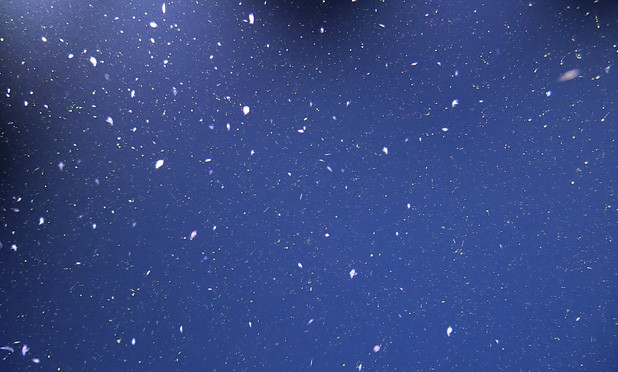First in-situ measurements of microplastic fluxes help answer the “missing plastic” question
150 million tons of plastic are polluting the ocean today – and because of its slow decay, the amount keeps growing. Current model calculations indicate that only about one percent of the plastic can be detected at the ocean surface, where it is supposed to float due to its buoyancy. About 10,000 times more is found on the sea floor. So how exactly does it get there? A better understanding of the underlying dynamics helps protect the ocean against plastic pollution and related risks for marine life, the food web, and material cycling, including the carbon pump that is crucial for the ocean’s ability to take up carbon dioxide and mitigate climate change.
Presenting for the first-time data of plastic export from the ocean surface to the deep for the North Atlantic Gyre based on in situ measurements, scientists from Germany and the United States of America shed new light on the vertical fluxes of microplastics. In the scientific journal Environmental Science and Technology, they explain how the particles are entrapped in marine snow – organic material that sinks down the water column and serves as food for plankton and larger animals. Confirming earlier results of modeling approaches, the observations help answer the “missing plastic” question.

“Tiny plastic particles that are between 0.01 and 0.1 millimeters in size disappear from the ocean surface because they become part of the marine snow. Bigger pieces can take the same route but also sink faster due to their larger mass,” says Dr. Luisa Galgani, lead author and a Marie Curie Global Fellow at GEOMAR Helmholtz Centre for Ocean Research Kiel (Germany) and the Harbor Branch Oceanographic Institute of Florida Atlantic University (USA). Using special sediment traps and various optical and chemical analyses, researchers located the highest mass concentrations of plastic polymers in depths between 100 and 150 meters. Highly sensitive analytical methods enabled the quantification of even the smallest amounts of microplastics. The international team of researchers worked with The University of Texas Marine Science Institute to help pinpoint the type and size of the plastics. “Using our instruments, we were able to look at a marine snow sample, pick out what was plastic, and ID both the type and size,” said co-author and graduate student Xiangtao Jiang.
The abundance of microplastics in the seawater makes them a new component of the marine carbon cycle. In the samples from the North Atlantic Gyre, a hot spot of plastic litter, up to 3.8 percent of the organic carbon downward flux could be traced back to carbon originating from plastic. “This is an incredible amount of plastic in the snow, and it shows that marine snow is a large mechanism that is moving plastic to the bottom of the ocean,” said co-author Dr. Zhanfei Liu, Associate Professor at The University of Texas Marine Science Institute.
In the sunlit upper few hundreds of meters, also plankton and other marine life find their food from marine snow. “The more plastic particles are included in the marine snow, the greater the risk for marine life that feeds on it,” says Dr. Galgani.
Drs. Galgani, Liu and Xiangtao Jiang are joined in the study by co-authors Isabel Goßmann and Barbara Scholz-Böttcher with Carl von Ossietzky University of Oldenburg, Germany; Lindsay Scheidemann, Cathleen Schlundt, and Anja Engel with GEOMAR Helmholtz Center for Ocean Research Kiel, Germany.
This project is supported by the Helmholtz Association of German Research Centres, the Federal Ministry of Education and Research (BMBF) funded research project FACTS (ID 03F0849B and 03F0849C) within the JPI-Oceans programme, the US American National Science Foundation (#2033828) as well as the EuropeanUnion’s Horizon 2020 research and innovation programme under the Marie Sklodowska-Curie grant agreement No. 882682.
This release was adapted from a release created by the GEOMAR Helmholtz Center for Ocean Research Kiel, Germany.









